A city at the heart of Gabalian history |

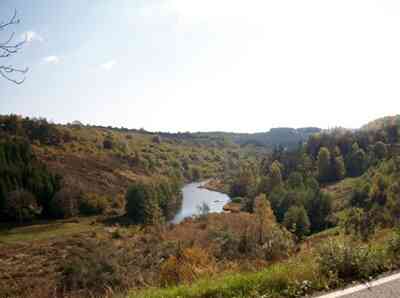 The origins of Langogne are unknown. The earliest records of its existence date back to the 2nd or 3rd century BC and derive from inscriptions engraved on pottery made in Banassac, a small village not far from La Canourgue.
The origins of Langogne are unknown. The earliest records of its existence date back to the 2nd or 3rd century BC and derive from inscriptions engraved on pottery made in Banassac, a small village not far from La Canourgue.
Specimens of this pottery, preserved by various museums, bear the inscription: Lingonis feliciter (Greetings to the people of Langogne). The dedication obviously applied to a fairly significant number of inhabitants. It can therefore be inferred that they were already numerous enough to constitute an agglomeration. And if it is understood that a city does not arise spontaneously, it must be admitted that its formation dates back to a time before the Roman occupation. Let us lament, along with Aulus Hirtius, Caesar's lieutenant, that the Gabales ignored the art of castra-building and left no construction that would give an approximation of the city's birth.
The idea has indeed been suggested that the chapel of Notre-Dame de Tout-Pouvoir could be an ancient building and, with a bit of imagination, a pagan temple, transformed into a primitive Christian oratory and incorporated into the structure of the Benedictine church. However, this assumption remains relative, as it can only be substantiated by the sinking of its foundations approximately one meter into the ground compared to the level of the sanctuary's flooring.
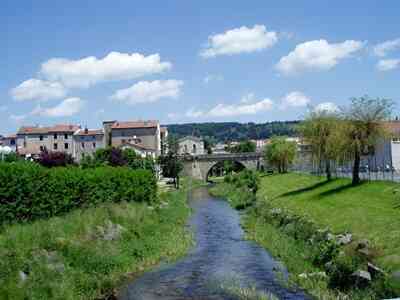 The old bridge, formerly named "Pont de Peyre", whether this name referred to the materials it was built from or designated a place name or that of a riverside owner, bears the imprint, style, and architectural form of Roman constructions of this kind, but it has been modified so many times that it is difficult to assign it an exact date of origin.
The old bridge, formerly named "Pont de Peyre", whether this name referred to the materials it was built from or designated a place name or that of a riverside owner, bears the imprint, style, and architectural form of Roman constructions of this kind, but it has been modified so many times that it is difficult to assign it an exact date of origin.
There are no remains of a Roman "villa" in the region like those in Javols or Florac, nor any of the materials used in transalpine works: marble, glazed bricks, tiles, ceramics, mosaics, bronze ornaments.
A hypothesis has been put forward regarding a primitive settlement of Langogne near the castra of Mont-Milan; however, nothing supports this view. There is no trace of habitation, necropolis, sarcophagus, tumulus, or even a lakeside city in the Ponteyre marsh, which would support this hypothesis, while the marked preference of the Gauls for seeking out valleys sheltered from the winds and by watercourses to establish their "camps" would more reasonably explain the choice of relocating the town at the foot of and sheltered by the Beauregard hill and in the valley of Langouyrou for its domestic convenience. The crossroads of paths, starting from the original ford of this stream, would also advocate for the creation of a habitat at this point for easier communication and traffic.
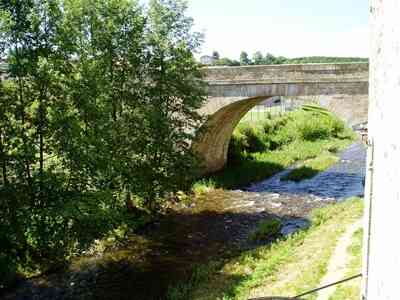 The original name of Langogne, derived from Langouyrou (long stream), further confirms its location along its banks.
The original name of Langogne, derived from Langouyrou (long stream), further confirms its location along its banks.
The derivation of the Celtic name Lengouôgno, later Frenchified to Langogne, but still maintained with its exact original sound through dialect, facilitates the etymological explanation of this proper name. Indeed, when relating it to the noun ru, which means small stream, it is noted that the Latin pronunciation of u as ou results in ru being articulated as rou (cf. Latin, virus). The ending ou is also popular in many proper names in the region: Badaroux, Chapeauroux, Auroux, Congourou, Langouyrou. Furthermore, given the certainty that the Gauls deified watercourses, either as gods or goddesses, it can be inferred that the qualification of "mothers" given to the latter allows for the transcription of the Celtic or Breton naehe as na or nae in Latin. Such mutations are numerous; for example, in Bourbonne, which comes from "Borbonaehe", Huveaume key "Uvelnae", Pradelles from "Pratellae", Fontanes from "Fontanae". Without hesitation, one can therefore say that the Celtic designation of Longouy (rou) takes the form of Longouy (naehe), which, Latinized, will be Longouy (na) and by the action of the nasal yod, n will arise as Lingonia in Latin, which is none other than Lengouôgno in dialect and Langogne in French.
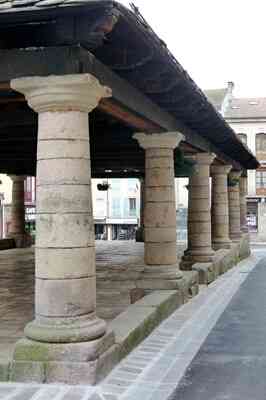 Completing detail. The derivation nh Occitan, equivalent to the French gn, often encountered in proper names of Gévaudan, particularly makes "Gogolùg enhe" from Cogoluène, thus reinforcing the transformation of "Len gonaehe" into Langogne.
Completing detail. The derivation nh Occitan, equivalent to the French gn, often encountered in proper names of Gévaudan, particularly makes "Gogolùg enhe" from Cogoluène, thus reinforcing the transformation of "Len gonaehe" into Langogne.
The likelihood of the origin of the name Langogne demonstrated by these similarities obliges us to dismiss the assumptions of some historians, who do not seem to have made much effort to discover an etymology, unless they have cautiously copied each other.
Mr. Abbé Fourcher and Mr. Ignon, too easily, derived from the Latin suffix ligo (hoe), which is of Germanic origin "houwa", the word ligo-nia and by tortuous alteration fabricated lingonia, to reach, one does not know how, Langogne. This interpretation lacks foundation and raises strong opposition.
The most pertinent is certainly the use of a Latin word to have roots in the name of a city while its natives, old Gabales, had no other language than Celtic and did not even know if Latin existed. It is also certain that they did not wait for the Roman invasion to name their village. Are not the proofs of its existence prior to the arrival of Caesar's legions provided by the dedications of the potters of Banassac?
And then Ligo, if it means hoe, also means "to bind, to attach, to join, to unite", so it would have been just as elegant, instead of making a farming tool the name of the city, to suppose that the Gabale had "bound, attached" itself to its land and that thus its designation corroborated its feeling of affection and attachment.
Moreover, the dithyramb exalted by "the clearing with the hoe of the soil, cradle of the city" of Mr. Grasset would not validate his finding of deriving from the two hoes depicted in the coat of arms of Langogne the sought synonymy. Had he forgotten that the coats of arms date from the 11th century and therefore came a bit late to give him a name?
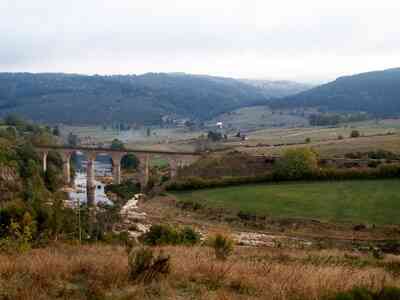 More cautiously, Messrs. Cord and Viré content themselves with recalling the Latin inscription from the pottery of Banassac without worrying about researching or tracing the origin of the name.
More cautiously, Messrs. Cord and Viré content themselves with recalling the Latin inscription from the pottery of Banassac without worrying about researching or tracing the origin of the name.
Mr. Lhermet, an eminent Latinist, admits he found nothing in the "Commentaries" relating to the existence of Langogne, not even a mention of the place. It is true that he will not speak further of Mont-Milan, where his legions were stationed and presumably fortified as an oppidum, that is to say, a war place.
He does not see any possible relation between the Latin ligo and the Celtic Lengouôgno. On the other hand, he would support a vicus at Mont-Milan, transferred according to the inclination of the Romans, once masters of a country, to destroy the mountain oppida, natural strongholds, and as a security measure, to move the habitat to the plain.
Was not Bibracte replaced by Augustodunum (Aulun) and Gergovia by Augustonemetum (Clermont)? Moreover, as he admits the presence of a lake at Ponteyre, at the foot of Mont-Milan, and its drying up, more than improbable, by the Romans, it would explain that "the gods of the waters" would have found asylum at the confluence of Langouyrou and the Allier, perhaps bringing an imaginary ancient statue, a bicéphale representation of a druidic divinity that would have become that of the two rivers, transformed, by bold supposition, into the Virgin of the Christian sanctuary. Although very appealing as a sweet legend, the movements of the vicus and the pagan icon, remaining without probative basis, barely remain as hypothetical fantasies.
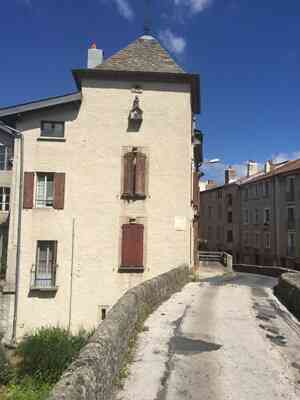 History fixes, from the year 27 before Christ to the year 472 of our era, the presence of the Romans on Gabal territory. Few details remain from this long domination which made the land a colony reduced to slavery, under the severe law, customs, language, and religion of the occupant.
History fixes, from the year 27 before Christ to the year 472 of our era, the presence of the Romans on Gabal territory. Few details remain from this long domination which made the land a colony reduced to slavery, under the severe law, customs, language, and religion of the occupant.
The period that followed, confirming a political and religious emancipation, was quickly marred by invasions from Barbarians, Visigoths, Franks, and then by the cascade of incompetent kings who brought France to the feudal period, did not improve the fate of a small town that lived secluded in the mountains of Gabal land and had only regained a religious peace, still very relative, through the extension of Christianity.
The determination of human origin is as troubling and uncertain as that of its destiny. If the believer accepts the supposed principle of creation and the order of existence in the light of dogmas and legends, while the skeptic acknowledges the hypothesis in the matter and confesses his powerlessness to penetrate the mystery of his origin, as much as of his destiny, there remains only the chance to discover some data or traces to clarify the unfathomable problem that has so far been unsolvable.
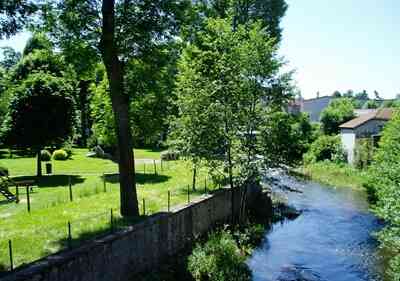 The historical period revealed to us goes back barely five or six thousand years before our era, beyond which there is only improbability and ignorance. Certainly, geology and archaeology, while not always in agreement, strive to push back the boundaries of our primitive knowledge, but while we have seen the obvious transformations of the Earth's globe, the constitution and evolutions of the astronomical universe, the gleanings of discoveries have yet to determine the origin of the human being, nor the actual time of its appearance.
The historical period revealed to us goes back barely five or six thousand years before our era, beyond which there is only improbability and ignorance. Certainly, geology and archaeology, while not always in agreement, strive to push back the boundaries of our primitive knowledge, but while we have seen the obvious transformations of the Earth's globe, the constitution and evolutions of the astronomical universe, the gleanings of discoveries have yet to determine the origin of the human being, nor the actual time of its appearance.
In the current state of science, which also modifies and transforms its explanations in light of incessant and new discoveries, man is found at the end of the Mousterian period, through chipped and shaped stone, rough pottery, naive drawings in caves, and the primitive use of fire. Fossils of bones confirm his existence, without providing the exact characteristics of his conformity.
Accepting these data, we can recognize two types of men, unequally evolved and of different shapes. The oldest, with a delicately shaped head, that is to say a receding forehead, protruding jaw, a hint of chin, eyes set deep under strongly folded bony orbits, bestial, about one meter fifty in height, with a stocky trunk and short limbs. The other, with a brachycephalic head, whose length exceeds its width by a quarter, has a structure that brings it closer to modern man. Its upright stature maintains an analogy with the individual of the first type, who, in turn, has relations with the anthropoid ape, so that a derivation, pursued until the acquired superiority, is to be presumed, not only from a slow transformation of the body but from a progressive intelligence, in proportion to the increase in brain volume.
The presence of evolved man is fixed in the Gabal territory at a time dating back more than 3,000 years before our era. This man is undoubtedly linked to the Gallic clan that came from the East, of this Aryan race, Asian, which, according to the Bible, is descended from Noah's son, Japheth, third after Shem and Ham. Following prolific multiplication and the need to live, he would have emigrated westward to settle in the space blocked by the great sea, where he would have already encountered the Iberian individual. The two types: one tall, blonde, with blue eyes; the other smaller, brown, with black eyes, would have mixed and over time become indistinguishable.
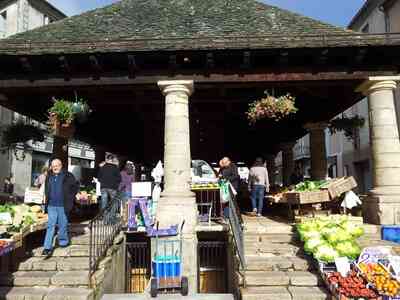 The clan embedded in the Gabale land lost its sense of migratory nomad to become shepherds, farmers, artisans, loving family life. It revealed delayed growth due to the cold climate, lack of limestone, and insufficient food. Its race would be preserved almost intact, without much mixing, due to a sedentary lifestyle. Its members were brave, enterprising, generous, mocking, enthusiastic, willing to quarrel and enjoyed fighting. They asserted themselves as passionate about independence and freedom, and deeply patriotic. They became the Gavauts or Gabales, that is to say, inhabitants of the province of Gabalum.
The clan embedded in the Gabale land lost its sense of migratory nomad to become shepherds, farmers, artisans, loving family life. It revealed delayed growth due to the cold climate, lack of limestone, and insufficient food. Its race would be preserved almost intact, without much mixing, due to a sedentary lifestyle. Its members were brave, enterprising, generous, mocking, enthusiastic, willing to quarrel and enjoyed fighting. They asserted themselves as passionate about independence and freedom, and deeply patriotic. They became the Gavauts or Gabales, that is to say, inhabitants of the province of Gabalum.
The history of Langogne is intimately linked to that of Gévaudan. Its administration and religion are summarized in the traditions of the Gallic nation. They were based on the tribe constituted within the family clan. These clans appointed a president, vergobert, who, when gathered, formed a senate responsible for administration. Military and religious leaders were also elected.
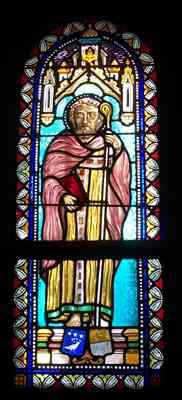 The religion was based on two deities: the Earth and the Sky, with an infinity of gods and dedicated cults: to the springs, the bubbling god; to thunder, the Toran; to the sun, Belen; to war, Esus; to the protective lar of the hearth, Teutatès. For the service of the gods were the seers, druids, bards, ovates, druidesses, kinds of fairies.
The religion was based on two deities: the Earth and the Sky, with an infinity of gods and dedicated cults: to the springs, the bubbling god; to thunder, the Toran; to the sun, Belen; to war, Esus; to the protective lar of the hearth, Teutatès. For the service of the gods were the seers, druids, bards, ovates, druidesses, kinds of fairies.
Feudal in its religion, satisfied with its administration, very patriotic, the Gabale did not admit intrusion on its territory, which it defended with weapons in hand and protected with a series of castra perched on high peaks that also served as points of concentration and departure for punitive actions against the Helvii, who became allies of the Romans, or to assist the Arvernians, besieged by the transalpine legions, as well as for refuge and defense.
Thirty thousand men, it has been claimed, would have probably left the oppidum of Mont-Milan to rush to the aid of the Arvernians, commanded by Vercingetorix and attacked by Julius Caesar. Beaten separately by the Roman army, they left hostages in its hands, but they were returned to their homes instead of being slain as conquered by the sword or taken into slavery. This magnanimous concession from a great strategist was meant to allow the invasion, without a fight, of the Gabale land by Caesar's army.
From this moment on, the Romans settled permanently, reducing the people to slavery. They destroyed druidism, which was more of a corporation than a religion, by hunting down the druids who stimulated the patriotism and warrior spirit of the masses. They themselves had no religion and only practiced a sort of polytheism, established in idolatry, which even deified their emperors. It was necessary to wait for the decline of Rome and the appearance of Christianity to overturn this anachronism.
When Christianity spread from the East, gaining Gaul through the shores of the Mediterranean filled with Levantine trading posts, the new religion was eagerly accepted since it promised deliverance, freedom, and brotherhood. After many hesitations, Catholicism adopted the principle of the administrative organization of Rome. Preachers formed cénacles or churches. Each of them chose the most deserving to become its priest, who, grouped together, elected a bishop. Together, they appointed archbishops and their supreme leader, the pope. There were heresies, schisms, persecutions, but finally, the religion tolerated and then embraced by Emperor Constantine took root at the time when the fall of Roman power left Gaul the opportunity to shake off a yoke that had oppressed it for several centuries. The Gabale, which had suffered the vicissitudes of its homeland, stood up emancipated and Catholic.
Former holiday hotel with a garden along the Allier, L'Etoile Guest House is located in La Bastide-Puylaurent between Lozere, Ardeche, and the Cevennes in the mountains of Southern France. At the crossroads of GR®7, GR®70 Stevenson Path, GR®72, GR®700 Regordane Way, GR®470 Allier River springs and gorges, GRP® Cevenol, Ardechoise Mountains, Margeride. Numerous loop trails for hiking and one-day biking excursions. Ideal for a relaxing and hiking getaway.
Copyright©etoile.fr